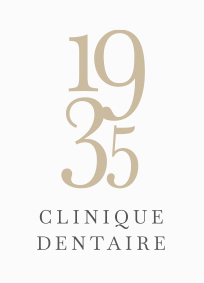Dental restoration and Clinique Dentaire 1935: a winning combination
Dental restoration is an effective solution for repairing badly damaged teeth. There are different types of restorations, onlays and inlays, depending on the part of the tooth that needs to be repaired.
An onlay is an indirect filling that covers part of the tooth surface like a 3/4 crown. In these cases, the restoration is tightly cemented to the coronal part of the tooth to be restored. In contrast, an inlay, which is a high-quality dental restoration, is cemented into the cavity itself up to the walls of the tooth. This restoration fills a damaged tooth but does not cover it.
When it comes to dental restorations, Clinique Dentaire 1935 is happy to meet your needs. For an appointment or to discuss your needs with a member of our staff, please contact us now.
Why perform a dental restoration?
Onlays and inlays are offered in the case of severely damaged teeth or extensive cavities. These restorations reproduce the anatomy of a healthy tooth and play a very important role, not only from an aesthetic point of view, but also in restoring the ability to chew properly.
These prostheses perfectly reconstruct the tooth, both in shape and colour, and it is generally not necessary to devitalize the tooth. In terms of material, ceramics and porcelain are widely used, but some people prefer gold because of its outstanding durability. On the other hand, ceramics and porcelain have the advantage of being more resistant and aesthetically pleasing.
How is a restoration performed?
Dentists divide their work into three phases to make a dental restoration.
The first phase is to carve the tooth cavity. As with the dental crown, the dentist cuts the tooth and takes a dental impression. The quality of the impression is essential for the dental technician to make a restoration that fits and adapts to the tooth.
The second phase focuses on the preparation of the restoration. The inlay or onlay undergoes a heat treatment, i.e. a firing that increases its hardness and durability. The cement used often consists of light-curing or self-curing resin. Thirdly, and finally, the dentist finishes by adjusting the occlusion of the inlay and polishing the restored tooth.
Aftercare and follow-up after restoration
It is very important to maintain proper oral hygiene. During the dental cleaning and check-up, the dentist will make sure that the plaque around the restorations is under control. If necessary, the dental hygienist will give you appropriate recommendations. It is important to ensure that inlays are always tight. Cavities should be prevented from forming at the meeting point between the tooth and the restoration..
Choosing Clinique Dentaire 1935 for a dental restoration
An inlay is an indirect filling that is placed inside the tooth without cuspid overlap, unlike an onlay or a dental crown. This fixed restoration is made of ceramic, porcelain or gold and can be used to reconstruct part of a tooth that has been badly damaged by a cavity or tooth fracture.
The choice between onlay and inlay is made according to the extent of the cavity to be restored and the loss of tooth substance, as well as the oral hygiene and age of the patient. Your dentist is the best person to advise you on this.
To learn more about this technique, contact Clinique Dentaire 1935, located a stone’s throw from the Papineau metro station. We will provide you with all additional information. If your situation requires immediate assistance, our emergency dental service is available to you.
